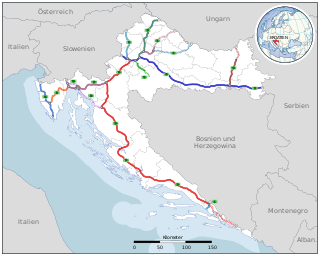This article needs additional citations for verification .(October 2021) |
This article needs additional citations for verification .(October 2021) |
Already in the Middle Ages, there were several libraries in Croatia. The oldest one was the library of the Cathedral of Saint Domnius in Split; the preserved manuscript of the Greek-Latin Evangelist of Split testifies to the existence of it (7th century). [1] During the Renaissance and Baroque, some private libraries were established, for instance the library of Marko Marulić, a Renaissance humanist, or Bibliotheca Zriniana , the prominent book collection of Nikola VII Zrinski, Ban (Viceroy) of Croatia (1662).
The evolution of Croatian libraries later occurred in three distinct phases:
Reading rooms, the precursor to public libraries, first appeared in Croatia in the late 1830s. Similar to other Western countries, reading rooms were places where men with common views could meet and discuss issues in solidarity. Driven by their opposition to Austro-Hungarian rule, libraries in Croatia were created with the intention of nurturing the "Croatian language and culture, as well as national awakening and identity." [2] The founders stipulated that reading material must be written in Croatian. [2] These rooms were often referred to as Illyrian reading rooms, named after the political and cultural Illyrian movement. The first Illyrian reading room opened in Varaždin in January 1838. Others soon opened, and by the end of the nineteenth century, more than 180 reading rooms were operating in Croatia. [2]
Reading rooms started functioning as libraries rather than just a place to discuss political activities. [2] [3] –
Libraries that are publicly funded began to appear in Croatia during the 20th century. However, World War I slowed down the progress of libraries. The lack of progress can be attributed to Croatia joining the Kingdom of Yugoslavia, where individual and national rights were restricted. [3]
After WWII, Croatia became one of the six republics of the Socialist Federal Republic of Yugoslavia. Citing post war enthusiasm, author Dijana Sabolović-Krajina writes that libraries open in great numbers. [3]
The Librarianship Act of 1960 is passed. Librarianship and libraries in Croatia strengthen thanks to a "set legal and professional framework for all types of libraries." [3]
During the Croatian War of Independence, libraries, many libraries experienced disruption to patron services due to the conflict. More than 200 libraries, as well as museums and archives sustained some sort of damage or were destroyed, including valuable and irreplaceable historical collections. Rebuilding libraries postwar became a “top priority at the close of the twentieth century.” [4] Unlike other Eastern Bloc countries, Croatians were free to travel to the West. As a result of this contact, Western libraries "influenced the character and progress of Croatian libraries and librarianship before and after the 1990s." [4]
After the war ended and the country gained independence, Croatia transformed from a socialist republic to a political and economic democracy. In 1997, the government passed the Library Act, a law decrees that a public library should be established in communities with more than 5000 residents. However, not all communities are able to comply with this law due to limited finances or resources. [3]
According to statistics, it is estimated that there were a total of 1,731 as of 2010. This includes libraries that fall into public, national, university or higher education, church, general education, and special library categories. [4] Academic, special, and research libraries are governed by the Ministry of Science, Education, and Sports, while the Ministry of Culture is responsible for public libraries. Both are governed by the Croatian Library Council. [4]
In 2016, Croatian public librarians collaborated with EIFL to help develop a vision on what libraries could do to improve the country. They arrived at four goals: provide advanced digital skills that help young people become employable in technical fields, help foster interest in creative industries, improve access to those living in rural areas, and promote social inclusion. [5]
As with other libraries world-wide, the country's libraries closed or scaled back services during the COVID-19 pandemic. The Croatian Library Council urged libraries to work and, as far as possible, remain "accessible to users as important support to the community" [6]


At the time of the Roman Empire, the area of modern Croatia comprised two Roman provinces, Pannonia and Dalmatia. After the collapse of the Western Roman Empire in the 5th century, the area was subjugated by the Ostrogoths for 50 years, before being incorporated into the Byzantine Empire.

Transport in Croatia relies on several main modes, including transport by car, train, ship and plane. Road transport incorporates a comprehensive network of state, county and local routes augmented by a network of highways for long-distance travelling. Water transport can be divided into sea, based on the ports of Rijeka, Ploče, Split and Zadar, and river transport, based on Sava, Danube and, to a lesser extent, Drava. Croatia has 9 international airports and several airlines, of which the most notable are Croatia Airlines and Trade Air. Rail network is fairly developed but regarding inter-city transport, bus tends to be far more common than the rail.

Zadar, historically known as Zara, is the oldest continuously inhabited city in Croatia. It is situated on the Adriatic Sea, at the northwestern part of Ravni Kotari region. Zadar serves as the seat of Zadar County and of the wider northern Dalmatian region. The city proper covers 25 km2 (9.7 sq mi) with a population of 75,082 in 2011, making it the second-largest city of the region of Dalmatia and the fifth-largest city in the country.

The Kingdom of Croatia entered a personal union with the Kingdom of Hungary in 1102, after a period of rule of kings from the Trpimirović and Svetoslavić dynasties and a succession crisis following the death of king Demetrius Zvonimir. With the coronation of King Coloman of Hungary as "King of Croatia and Dalmatia" in 1102 in Biograd, the realm passed to the Árpád dynasty until 1301, when the (male) line of the dynasty died out. Then, kings from the Capetian House of Anjou, who were also cognatic descendants of the Árpád kings, ruled the kingdoms. Later centuries were characterized by conflicts with the Mongols, who sacked Zagreb in 1242, competition with Venice for control over Dalmatian coastal cities, and internal warfare among Croatian nobility. Various individuals emerged during the period, such as Paul I Šubić of Bribir, who was representing the most powerful Croatian dynasty at the time, the Šubić noble family. These powerful individuals were on occasion able to de facto secure great deal of independence for their fiefdoms. The Ottoman incursion into Europe in the 16th century significantly reduced Croatian territories and left the country weak and divided. After the death of Louis II in 1526 during the Battle of Mohács and a brief period of dynastic dispute, both crowns passed to the Austrian House of Habsburg, and the realms became part of the Habsburg monarchy.

Biograd na Moru, shortened to simply Biograd, is a town in northern Dalmatia, Croatia and is significant for being another capital of the medieval Kingdom of Croatia. Biograd is administratively part of the Zadar County. It is located on the Adriatic Sea coast, overlooking the island of Pašman, on the road from Zadar and Sukošan towards Vodice and Šibenik.
Mile Krajina was a noted gusle player from Croatia, who sang traditional folk songs.
Operation Maslenica was a Croatian Army offensive launched in January 1993 to retake territory in northern Dalmatia and Lika from Krajina Serb forces, with the stated military objective of pushing the Serbs back from approaches to Zadar, Maslenica and Karlobag, allowing a secure land route between Dalmatia and northern Croatia to be opened. While an undoubted net Croatian tactical success, the operation was only a moderate strategic success, and was condemned by the UN Security Council.
Ivan Karlović, also known as by his Latin name Johannes Torquatus, was the Count of Krbava. His life during critical periods of Hundred Years' Croatian–Ottoman War was marked by constant efforts to stop Ottoman conquests of Croatia, during which he held position of Ban of Croatia twice: from 1521 to 1524 and again from 1527 to 1531. He was also one of the Croatian magnates who participated in 1527 Election in Cetin.
The Croats are an ethnic group in Slovenia. In the 2002 census 35,642 citizens of Slovenia identified themselves as Croats, making them second most-populous non-Slovene ethnic group in Slovenia. Despite their centuries-old presence, Croats do not have the status of a national minority.

Matica hrvatska is the oldest independent, non-profit and non-governmental Croatian national institution. It was founded on February 2, 1842 by the Croatian Count Janko Drašković and other prominent members of the Illyrian movement during the Croatian National Revival (1835–1874). Its main goals are to promote Croatian national and cultural identity in the fields of art, science, spiritual creativity, economy and public life as well as to care for social development of Croatia.
The Battle of Zadar was a military engagement between the Yugoslav People's Army, supported by the Croatian Serb Serbian Autonomous Oblast of Krajina, and the Croatian National Guard, supported by the Croatian Police. The battle was fought north and east of the city of Zadar, Croatia, in the second half of September and early October 1991 during the Croatian War of Independence. Although the JNA's initial orders were to lift the Croatian siege of the JNA's barracks in the city and isolate the region of Dalmatia from the rest of Croatia, the orders were amended during the battle to include capturing the Port of Zadar in the city centre. The JNA's advance was supported by the Yugoslav Air Force and Navy.

The Kingdom of Croatia was part of the Lands of the Hungarian Crown, but was subject to direct Imperial Austrian rule for significant periods of time, including its final years. Its capital was Zagreb. It was also a part of the lands of the Habsburg monarchy from 1527, following the Election in Cetin, and the Austrian Empire from 1804 to 1867.
Croatian art describes the visual arts in Croatia, and art by Croatian artists from prehistoric times to the present. In Early Middle Ages, Croatia was an important centre for art and architecture in south eastern Europe. There were many Croatian artists during the Medieval period, and the arts flourished during the Renaissance. Later styles in Croatia included Baroque and Rococo.

The National Library of Albania is Albania's national libraryheadquartered in the country's capital, Tirana. It was founded in 1920 and inaugurated on December 10, 1922.

Croatian Writers' Association is the official association of Croatian writers. It was founded in 1900 in Zagreb with the goal "to unite writers and help them support one another, and promote Croatian literature regardless of political objectives", "to protect the interests and increase the reputation of writers" and "supports its members and their orphans." The DHK's president is Hrvojka Mihanović Salopek, while Željka Lovrenčić and Mirko Ćurić are vice-presidents.

Theatre in Croatia refers to the history of the performing arts in Croatia, or theatrical performances written, acted and produced by Croatians. Croatian theatre generally falls into the Western theatre tradition, with influences especially from Italy, Germany, Austria and other European nations.

The Split Archaeological Museum is the oldest museum in Croatia, established in 1820 by a decree of the Dalmatian government in Zadar. Some 150,000 artifacts cover prehistoric times, the period of Greek colonization of the Adriatic, Roman Provincial and Early Christian era to the early Middle Ages and the period of Croatian popular rulers. There is a collection of stone inscriptions from Salona and the collections of Graeco-Hellenistic ceramic objects, Roman glass, ancient clay lamps, bone, and metal articles, gems and coins.
Ivan Derkos was a Croatian politician associated with the beginning of the Illyrian movement, the 19th-century Croatian national revival movement. He gained prominence by reading a series of notes written by Fran Kurelac in defence of lectures on the Croatian language held at the University of Zagreb by Matija Smodek in 1832.